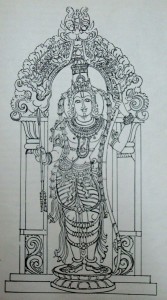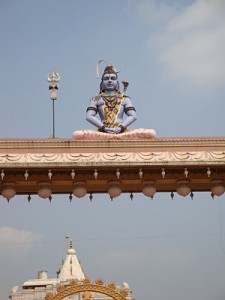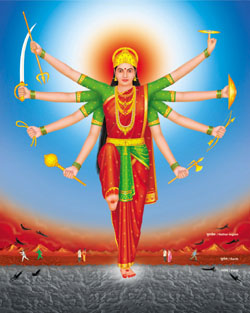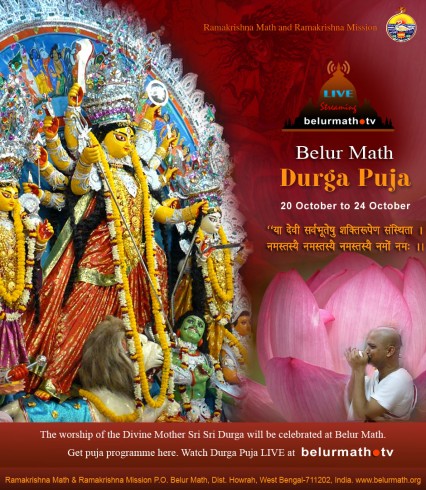Search results for navratri (4)
SRI SRI DURGA PUJA-2012
Belur Math Durga Puja LIVE at www.belurmath.tv
The worship of the Divine Mother Sri Sri Durga will be celebrated at Belur Math as per programme given below.
http://www.belurmath.org/news_archives/2012/10/14/sri-sri-durga-puja
#previous #articles #ramakrishna #vivekananda #yoga #vedanta
RAM NAWAMI IN ‘INDIA’, Prof. Chitralekha Singh

Rama (IAST: rÄ�ma, DevanÄ�garÄ�: राम; Lao: ພຣະຣາມ; Malay: Megat Seri Rama; Tagalog: Rajah Bantugan; Thai: พระราม) or Ramachandra रामचंद्र is the seventh avatar of Vishnu in Hinduism,and a legendary king of Ayodhya in ancient Indian mythology.
Rama is one of the many popular figures and deities in Hinduism, specifically Vaishnavism and Vaishnava religious scriptures in South and Southeast Asia.Most of the details of Rama’s life come from the Ramayana, one of the two great epics of India. Born as the eldest son of Kausalya and Dasharatha, king of Ayodhya, Rama is referred to within Hinduism as Maryada Purushottama, literally the Perfect Man or Lord of Self-Control or Lord of Virtue. Rama is the husband of Sita, whom Hindus consider to be an avatar of Lakshmi and the embodiment of perfect womanhood. Read More: > HERE <
Rama Navami (DevanÄ�garÄ�: राम नवमी) also known as Sri Rama Navami is a Hindu festival, celebrating the birth of Lord Rama to King Dasharatha and Queen Kausalya of Ayodhya. Rama is the 7th incarnation of the Dashavatara of Vishnu. The festival falls in the Shukla Paksha on the Navami, ninth day of the Chaitra month of Hindu calendar. Thus it is also known as Chaitra Masa Suklapaksha Navami, and marks the end of nine-day Chaitra-Navratri celebrations.
In the epic Ramayana, Dasharatha, the Emperor from Ayodhya, had three wives named Kausalya, Sumitra and Kaikeyi in the Treta Yuga, which follows the Satya Yuga and is succeeded by Dwapara Yuga. Their greatest worry was that they had no children, and so they had no heir to the throne in the Ikshvaku Kula or royal lineage of great, pious, wonderful Emperors. Rishi Vasistha suggests him to perform Puthra Kamesti Yagna, through which he can have a desired child.
Among the incarnations of the Supreme Being, that of Rama & Krishna are considered very significant for humanity as it was possible for human beings to relate to him in person. In the Ramavatar (Incarnation of Ram) hsis auspicious qualities were manifest and he set an example to mankind by his adherence to Dharma (Religion). Rama’s matchless prowess as a warrior and his valorus deeds have lent the name ‘Mahavira Vaibhav’. Kalyan Guna (Welfare to humanity) is the main evident of Lord Rama.
It was his Kalyan Guna that he condoned the faults in others even when they had caused harm to him. The most important instance was when Ravana stood helpless without arms in the battlefield it would have been very easy to finish him off if the feeling of revenge on the one who had abducted his wife and kept her under captivity had over ridden, his sence of Dharma in warfare. His propriety and his inborn trait of pardoning others faults came to the tore in this critical juncture. The other Quality which was singular in Rama was his easy accessibility to everyone because of his innate affability (Sausilya). He was not only the supreme being incarnate but also the prince-regent, heir to the emperor of the mighty kingdom of Ayodhya.
Rama endeared himself to one and all by his noble qualities during his exile in the forest, the manner in which Rama addressed Guha, touched by his service by declaring that he was indeed his brother. These are few examples of his holy and piousness.
In Ramayan 16 outstanding qualities of Lord Rama is referred as ‘Krishna’ he performed the very delecate task of proceedings as an envoy of the Pandava’s to explore whether peace could be ensured. In several ways he saved the Pandava’s.
Rama was a prince and as such he could not be assigned the job of an ambassador, however there was an occasion when he admired such a task by another and he felt sorry. He was denied a similar privilege and so in his next manifestation he himself volunteered to do this service. All Gods incarnation are identical in bringing out his concern for those who place their faith in him. Lord descended on the earth protect the pious and thereby revealed his easy accessibility the destruction of wicked men was also his concern but this could have been accomplished by his will.
‘Thyagraja’ the great writter has emphasised that Sri Rama is unique. He said that Rama is ‘Parabrahama’ he is his ‘Ishtadevta’ – He has written many songs in the praise of Lord Rama in ‘Harikambhojit Kirtana’ – He said “Rama is the one and only God. Oh Mind! why do you dissipate?” ‘He is Brahma, Siva, Indra, permanent and the antar yamin in all beings.’
„Hey Ram – Hey Ram“, is a great Devotional prayer sung in the praise of Hindus God Rama. A beautiful bhajan by Jagjit Singh. http://gita-blog.blogspot.com/
Rama is the character who is delighted and grateful even by one act of help by anyone and never entertains in his mind any hostility to one who has done him enormous harm.
Balmiki’s Ramayana is revered as the essence of the vedas itself and ‘Rama’ portrayed as the very passonification of dharma. The purpose of studying scriptured texts like ‘Ramayana’ is to the divine level. One can make his life sublime by a word of comfort to help another in distress. The script of Ramayana desist one from turning proud, when by divines grace one is placed is a high position or is intellectually superior. Ramayana is an epic of Moral values of human being, great source of in spiration to the whole of humanity. India as Ramayana’s birth place is well known and Ramayana has been part and parcel of the Indian way of life from time immemoriel.
Tulsidas has also witten’ Ram Charit Manas’ the history and the great story of ‘Rama’ as an epic which is very popular as it is described in a very simple manner to apporach to the heart of human being-.
Ramnawami is a great day when Rama was born in the Kingdom of Ayodhya King Dashratha & Kaushalya. Today her all incarnation a Shailputri, Brahmacharini, Chaudraghante, Kushmanda, Skandhamata, Katyayni, Kalratri, Mahagauri, Siddhidarti and on the last day on Nawami this year on 23rd March everybody celebrates the birthday of Sri Ram in all its gay mood wearing new clothes, meeting & greeting each other worshipping their Ishta Dev/Devi and congratulates each other.
Article by Prof. Chitralekha Singh
Dean: Institute of Visual, Performing Arts & Research, Mangalayatan University, Beswan, Aligarh.
Visit at: www.artistchitralekha.com
e-mail: chitralekha@artlover.com mob . 91 9319103482
- Ramayana or Ramkatha, NEWS on Festival of Ramkatha <
- Ramayana, Valmiki Ramayana, Adhyatma Ramayana, Tulasi Ramayana- Yogavasistha <
- VEDA, SMRITI, SRUTI on Dharma <
- MORARI BAPU – THE RAMAYANA EPIC POEM <
- Articles „DHARMA“ <
- http://en.wikipedia.org/wiki/Dharma –
- www.ramayoga.net
- Meet Morari Bapu, friends, studies, fans at fb <
- Meet Hinduism, studies, friends, fans at fb <
- According to the various Indian religions, such as Hinduism, Buddhism, Jainism, and Sikhism, beings that live in accordance with Dharma proceed more quickly toward dharma yukam, moksha or nirvana (personal liberation). The antonym of dharma is adharma meaning unnatural or immoral.
Shivaratri, most significant of all Festivals

> Int. Interreligiöser Kalender <
> 12 Jyotir Lingas, Seats of Lord Siva <
> OMKARESHWAR ASHRAM, SCHOOL PROJECT <
> SRI RAMANA SEVA ASHRAM – Message No. 132.<
On 12th febrauary 2010, Maharshivaratri(lord Shiva’s Birthday) is celebrated all over the world. Maha Shivratri or Maha Sivaratri or Shivaratri or Sivaratri (Night of Shiva or „Great Night of Shiva“) is a festival celebrated every year on the 13th night/14th day in the Krishna Paksha (waning moon) of the month of Maagha (as per Shalivahana or Gujarati Vikrama) or Phalguna (as per Vikrama) in the Hindu Calendar (that is, the night before and day of the new moon). The festival is principally celebrated by offerings of Bael (Bilva) leaves to the Lord Shiva, all day fasting and an all night long vigil. Ganja is traditionally used as an offering for Lord Shiva and his followers. Read More: > HERE <
Shivaratri — The most significant of all festivals
Shivaratri is celebrated every year with a lot of religious fervour and devotion. Devotees keep fast, make offerings on Shivaling and stay awake all night (jagarari) to get the blessings of God Shiva. Unknown to most of the devotees the festival of Shivaratri holds the mystery to something most crucial namely, how God liberates the entire humanity from sorrow and suffering.
Till this mystery is solved by God himself, Shivaratri is celebrated merely as an annual ritual sans its original significance and purpose. To truly celebrate Shivaratri it is vital to know as to who Shiva is and what the word ‘Ratri’ which means night has to do with Shiva. The Supreme Soul is one and souls are many. The Supreme Soul is the Creator and Director of the eternal World Drama and souls are the actors in it. By becoming pure souls can become a great soul (mahatma), religious soul (dharamatma) and a divine or deity soul (devatmd) but they cannot become Supreme Soul i.e. paramatma. Souls are the progeny and not a part of the Supreme Soul. God Shiva is the creator of all deities even Brahma, Vishnu and Shankar.
Devotees worship them as devtaya namaha (salutations to the lords or deities). In comparison, Shiva is always worshipped as Shiva Paramatmay Namaha (Salutations to God Shiva) and Om Namaha Shivay (I salute Shiva). Lord Rama and Lord Krishna are shown as worshipping God Shiva at Rameshwar and Gopeshwar respectively.
The light form of God Shiva has been idolized as jyotirlingam (pillar of light) in 12 famous jyotirlingam Shiva temples in India viz. in Kedarnath, Somnath and Mahakaleswar etc. The light form of God is worshipped in most of the faiths in the world. Interestingly, Shivaratri does not mean Shiva’s night. The festival commemorates God’s descent on earth to end the unlimited Ratri (night) of ignorance and suffering and to usher in the golden dawn of peace, harmony and happiness.
“ Feste und Fastentage im Hinduismus „
von SWAMI SIVANANDA, 25. Kapitel – Shivaratri
siehe: > www.yoga-vidya.de <
>„1-Woche-vor-Shivaratri-Vortrag-mit-Sukadev“ <
Here Ratri connotes that critical juncture in eternal world drama cycle when unrighteousness reaches its extreme and all human efforts to redeem the situation fail. It’s a period of extreme sorrow and suffering when the vices (bad habbits) of ego, lust, anger and attachment rule human thoughts and actions.
In Hindu scriptures there is mention of the night of Brahma and also the night of the shaktis or goddesses (Navratris). The night of Brahma signifies the age of ignorance and unrighteousness in which God’s first and purest creation, Brahma and the Brahmins, are clouded by ignorance and vices. When God Shiva comes and opens their third eye of wisdom by bestowing divine intellect, they are able to forge a mental link with Him and draw His power. They thus become Shiva Shaktis who destroy ignorance and vices in the world with the help of Shiva. The Navratri (festival of nine nights) is a memorial of the end of the unlimited ratri in which devotees invoke the blessings of Shiva Shaktis and sing praise of their divine actions. It is at such a time when God intervenes to perform the divine acts of re-creating the new world order of purity, peace and prosperity and destroying the old worldorder of viciousness, violence and deprivation, as described in the Bhagavad Gita.
Just as night ends and day dawns when the sun rises, in the same way to end the night of ignorance God Shiva, the Sun of Knowledge (Gyan Surya) incarnates at the fag end of Kaliyuga, in Bharat.
This period of spiritual enlightenment is sailed Sangamyuga (Confluence Age) in which the most auspicious confluence of the Supreme Soul Shiva and human souls takes place. This is the most elevated period in human world when God incarnates in an ordinary man’s body and names him Prajapita Brahma through whom He reveals the most profound cnowledge about the Creator and His Creation. He reveals the supreme wisdom of Rajyoga which helps human beings absolve their sins and attain their original purity and perfection. That s why God Shiva is knowledgefull and patitpavan (purifier).
He is also the liberator and guide whose incarnation sets in process the destruction of the unrighteous iron-aged world – the present Kaliyuga – and consequently the liberation of ill souls from sin and suffering. God Shiva guides all souls to the land of liberation – the souls world where freed from their bondages they live in peace and silence. Thus He is also called Mahakaal (the great death or the eternal time) whose advent signals the return of everything in Creation to its original state.
This purification leads to the creation of a new pure world order Satyuga. It is the time on the world drama cycle (Srishti Chakra) which is remembered as Paradise, Heaven, Vaikunth, or Swarg where complete purity, peace and prosperity prevailed.
That is why the supreme Father of all souls is called the Creator and Shiva, which means the benefactor of all, who does good to every soul by incarnating in this world.
And the happiest news is that this golden key which opens the gates of the Golden age, Satyuga or Paradise is being given right now by Supreme Soul God Shiva himself to His spiritual children who have recognized His incognito incarnation in the human medium of Adi Dev Prajapita Brahma.
It is now that we have to awaken the soul (jagarari) and stay in the remembrance of God Shiva (up-vas means to stay close) take the oath of celibacy, sacrifice the bitterness of vices (bad habbits) on Shiva, and let the divine knowledge of Shiva flow drop by drop to all souls.
By adopting this true method of celebrating Shivaratri we should claim the greatest blessing mukthi , liberation in life, from God Shiva in this birth.
NAVARATRI – NINE DIVINE NIGHTS

>> Navaratri Festival Campaign <<
DIE 9 NÄCHTE DER GROSSEN GÖTTIN NAVDURGA
(19.09.2009, in India and everywhere)
Navaratri (Marathiनवरात्रि,Sanskrit: नवरात्रि, Bengali: নবরাত্রি, Tamil: நவராத்திரி, Kannada:ನವರಾತ್ರಿ) is a Hindu festival of worship and dance. The word Navaratri literally means nine nights in Sanskrit; Nava meaning Nine and Ratri meaning nights. During these nine nights and ten days, nine forms of Shakti/Devi i.e. female divinity are worshipped.
Durga als Dreiheit der Natur – Göttliche Mutter Durga, welche in allen Geschöpfen in Form von Intelligenz, Barmherzigkeit & Schönheit existiert. Sie ist die Gemahlin von Shiva, welcher das Universum erschafft, erhält & zerstört. Ein Gruß an die Göttliche Mutter Durga, welche in allen Geschöpfen in dieser Form allgegenwärtig ist.
Durga Navaratri beginnt am ersten und endet am zehnten Tag nach Neumond des Monats Aswayuja (September/Oktober). Das Fest erinnert an den Sieg von Durga über Mahishasura, den büffelköpfigen Dämon. In Bengalen wird ihr Bild neun Tage lang verehrt und dann dem Wasser übergeben. Der zehnte Tag heißt Vijaya Dasami oder Dussera (der „zehnte Tag“). Am zehnten Tag werden in den Dörfern und Städten Prozessionen mit einem Durga-Bildnis abgehalten.
